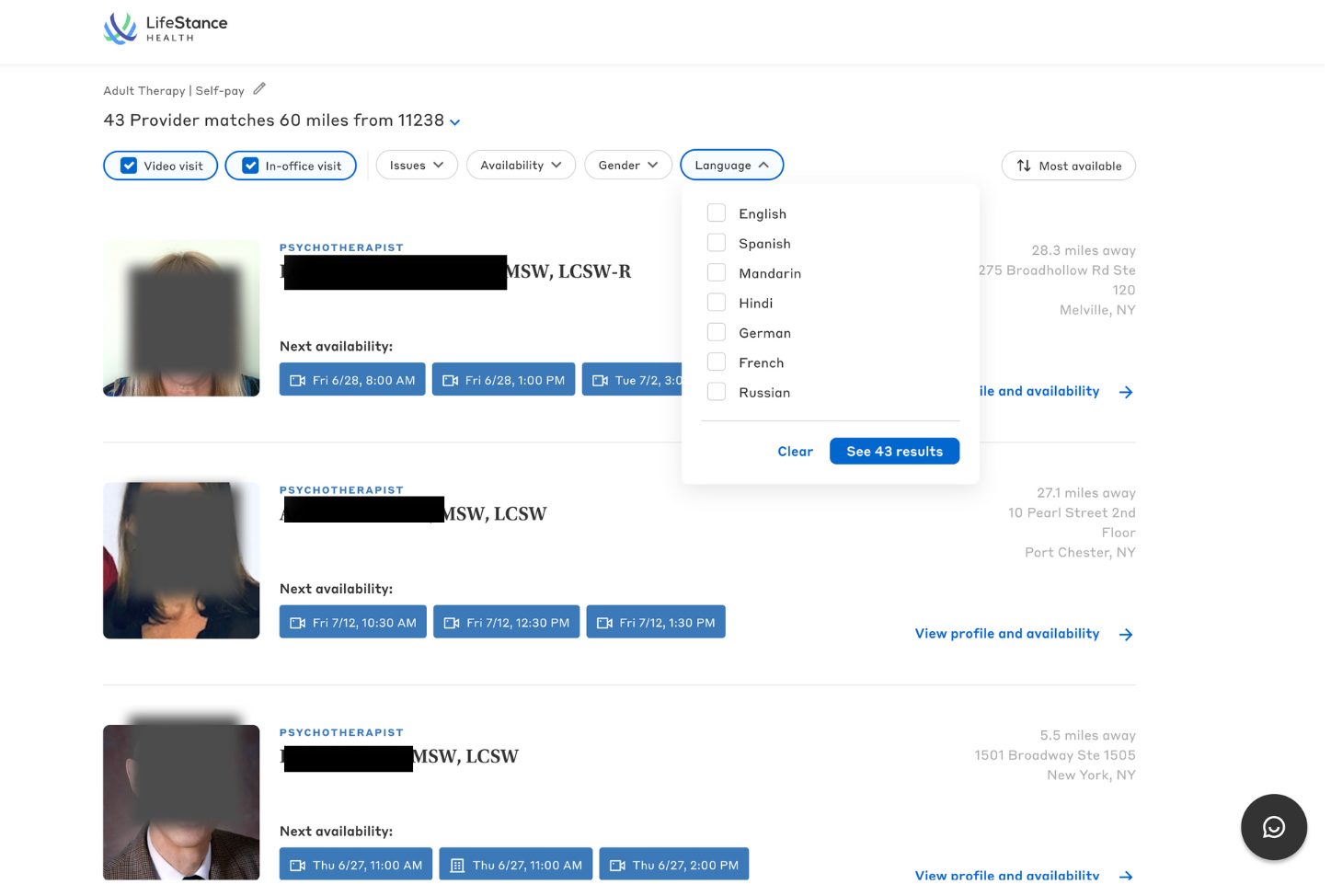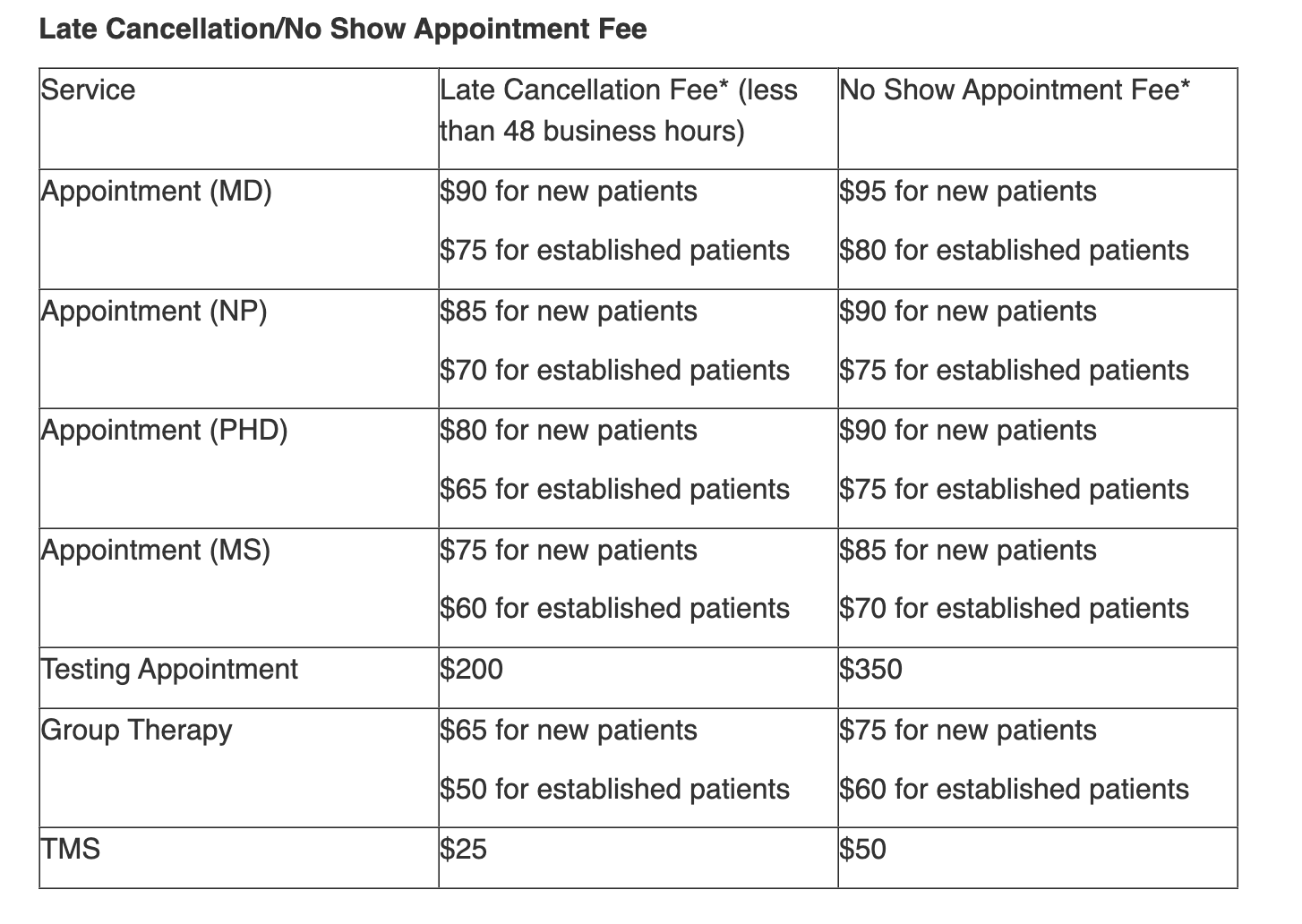Table of Contents
- The Handbook Team has spent over 10,000 hours researching more than 70 online therapy platforms. We identified the top 26 platforms and personally tested each one.
- We regularly facilitate focus groups and run surveys to understand the online therapy experience firsthand. To date, we have surveyed more than 2,000 online therapy users.
- Our LifeStance Health tester signed up for the platform booked, and attended online therapy sessions, and contacted customer service.
- Learn more about how we tested LifeStance Health.
Key takeaways
- LifeStance Health is not a good option for people paying out of pocket, as pricing and billing policies for people without insurance are not transparent.
- LifeStance has the highest per session costs without insurance of any online therapy platform we reviewed.
- LifeStance Health takes insurance from several large carriers, including Aetna, BlueCross BlueShield, and Cigna.
- LifeStance offers virtual therapy and psychiatry, including medication management.
- An alternative to LifeStance is Brightside, which offers subscription-based online talk therapy and psychiatry services.
LifeStance Health, also called LifeStance, is an online mental health platform offering talk therapy and psychiatry, with options for medication management and psychiatric evaluations. Although LifeStance accepts both insurance and out-of-pocket payment options, our comprehensive review of the platform raised concerns about the company’s high fees and lack of transparency in the billing process for people paying out of pocket.
In this LifeStance review, we share our tester’s experience with the platform, including information about costs, accessibility, and why the brand did not make our list of the best online therapy platforms.
LifeStance Health highlights
What is LifeStance?
LifeStance Health is an online therapy and psychiatry platform that offers a variety of mental health services, including the following:
- Adult therapy and psychiatry.
- Child and adolescent therapy and psychiatry.
- Medication management.
- Psychiatric testing and evaluation.
Similar to ZocDoc and Thriveworks, LifeStance allows users to search a directory of providers, with detailed bios for each provider. Unlike ZocDoc, LifeStance hosts sessions on its own virtual platform and has some in-person clinics where you can see providers in person.
LifeStance is available in 33 states. To find out if LifeStance is available in your state, click “Locations” in the website’s primary navigation.
How does LifeStance work?
The LifeStance platform offers therapy, medication management, and mental health evaluations. The platform employs a variety of mental health providers for these services, including licensed clinical social workers (LCSW) and licensed mental health counselors (LMHC) who provide talk therapy. Once you have found a provider, you can make an appointment either on the website or by calling customer service. Our tester found it was easiest to call to make an appointment.
Some LifeStance psychiatry providers are able to prescribe medications, including controlled substances for ADHD and anxiety where state laws and regulations allow.
How to sign up for LifeStance online therapy and psychiatry
Before creating an account or answering intake questions, you will need to go through the LifeStance provider selection process.
From the LifeStance homepage, you’ll select which service you’re interested in (Therapy, Medication, or Testing), enter your zip code, and click “Find a Provider.” If LifeStance offers care in the state where you live, you’ll be directed to a page with links to provider profiles.
You can use the filters at the top of the results page to help narrow your results. LifeStance provider filters include the following options:
- Video visit: Check a box to indicate your interest in virtual care.
- In-office visits. Check a box to indicate your interest in in-person care.
- Issues: This filter refers to specific concerns, such as ADD/ADHD or PTSD; populations, such as military members and veterans or people with head injuries; and interventions, such as cognitive behavioral therapy (CBT), including CBT for insomnia.
- Availability: Time of day you can see a provider and how soon you’d like to see someone.
- Gender: Preferred gender of provider, with options for female, male, and non-binary providers.
- Language: Preferred language spoken by the provider.
The drop-down filter menus allow you to select more than one answer. Though the filters offer several options, our tester noted that therapists weren’t available for some of their preferences. For example, there were therapists in their area who spoke English and Spanish (and one who spoke Mandarin), but none who spoke Hindi or any of the other languages listed in the language filter.

LifeStance provider profiles include their credentials, specialties, and a personalized bio. Our Handbook Team especially likes that each provider profile includes a list of three similar therapists in your area so that you can explore other providers.
How to book and attend a LifeStance appointment
Our tester chose to book their first appointment through the website, but they note that you can also call LifeStance by phone to book a session. The phone number to call varies by location. You can find the right number for your location on their website.
If you book online, you will be asked whether the appointment is for you or your child. Then, you’ll create your profile with basic information, including your chosen name, pronouns, and gender identity. We appreciate the inclusivity of their sign up process.
After booking the appointment, you will receive a link to the Patient Portal, where you’ll be assigned a series of forms to fill out, including a patient services agreement and a HIPPA Notice. You can enter your payment information in the Patient Portal or wait for a customer service representative to call and collect your credit card information. If you choose virtual care, your confirmation email includes a link to attend your session.
As a self-pay patient, our tester was concerned that they went through the entire booking process without being told what they would be charged for the session. As a result, they ended up canceling their appointment and calling customer service the next day to find pricing information and rebook their appointment.
From our LifeStance tester:
“After booking and receiving confirmation, I still had no information on how much my session would cost. From Googling outside the site, I learned that a session would cost $75–$300 if self-paying, but I didn’t get any estimate from LifeStance itself. This was frustrating because I wanted to know how much I would be charged for a session.”
How to switch therapists or book follow-up appointments on LifeStance
You must call customer service to switch therapists or book follow-up appointments on LifeStance. It’s the same for rebooking appointments. Although the website says that patients can rebook their appointments through the patient portal, our tester wasn’t able to do that after canceling their appointment and had to call and speak to a representative, who said that returning patients can never book through the patient portal, and they weren’t sure why the website says you can. This was another frustrating detail of the LifeStance platform.
While rebooking via customer service, our tester was able to specify the time of the appointment and which conditions they wanted help with, but they didn’t have much control over the therapist they were paired with. Also, because they scheduled with a different therapist, they had to fill out all of their Patient Portal forms a second time, which was time-consuming.
Our tester received an email confirmation with a link to join the session the day before the first scheduled appointment. However, their therapist was ten minutes late to the 45-minute session, which meant the session was only 35 minutes long. While our tester feels that the therapist seemed competent and knowledgeable, the curtailed session time was very frustrating.
LifeStance additional features
LifeStance does not have a mobile app and has limited bonus features. Users can access a free online blog with mental health resources or listen to episodes of “Convos from the Couch,” a LifeStance Health podcast. Other online therapy platforms, like Brightside and Talkspace, have mobile apps for joining appointments and accessing additional features, such as webinars.
How much does LifeStance cost?
LifeStance lacks cost transparency for patients paying out of pocket. Our tester went through the entire booking process and never received pricing information, even after receiving an email confirmation for their appointment. Fees are not listed on the website, and when our tester called customer service to ask about pricing, the representative said they could not share the price of the appointment. Instead, they offered to send a good-faith estimate via the Patient Portal. Our tester waited to provide credit card information until they received the estimate, which was $160–$195. Once they received an estimate, they went through with the booking.
However, after their first session, our tester was charged $335 for their appointment, with no adjustment for the fact that their therapist arrived ten minutes late and didn’t extend the session length to make up for it. This is the highest rate for a single therapy session on any online therapy platform we’ve reviewed.
From our LifeStance tester:
“I received a bill for $335, which I thought was very high for a 35-minute session. I also received an estimate prior to the bill through my Patient Portal, saying they predicted the cost would be $160–$195. Charging almost $200 over the estimate felt a bit predatory to me.”
LifeStance additional fees
The LifeStance cancellation policy is restrictive. Fees can be as high as $200 for canceling an appointment with less than 48 hours’ notice.

LifeStance also charges a fee for prescriptions refilled outside of an appointment; $25 for regular refills and $45 for controlled substance refills.
Is LifeStance covered by insurance?
LifeStance works with many large insurance carriers, including BlueCross BlueShield and Humana. In many cases, people with health insurance are only responsible for a copay (partial payment) when receiving mental health services, but the amount varies according to your carrier and plan. The LifeStance website states that patients are financially responsible for any fees not reimbursable by insurance, including fees for late cancellations and missed appointments. For this reason, all users are required to file a credit card with the platform before their first appointment.
Although LifeStance accepts many insurance carriers, their pricing practices are so confusing and unclear that we did not include them on our list of online therapy that takes insurance.
Our experience with LifeStance customer service
The customer service representatives our tester spoke to were friendly but could not provide accurate pricing information. Also, the wait times were long, and hours were inconsistent. When our tester called at 5:15 p.m., the customer service desk was closed, even though it is advertised as being open until 6:00 p.m.
Overall, the customer service experience was disappointing, especially because so much of LIfeStance’s business is conducted via phone instead of online (such as booking return appointments or switching therapists).
From our LifeStance tester:
“Customer service was prompt to respond and very friendly. They were also helpful. But I do feel like their priority was to get a credit card number from me ASAP, even though they weren’t able to tell me the price of an appointment. This made me a bit wary of the service in general, and I definitely felt like my bill could change at any time, which I really didn’t like.”
Our LifeStance testing experience
The Handbook Team has spent over 10,000 hours researching more than 70 online therapy platforms. We identified the top 26 platforms and personally tested each one. We also regularly facilitate focus groups and run surveys to understand the online therapy experience firsthand. To date, we have surveyed more than 2,000 online therapy users.






To test LifeStance Health, we worked with an independent tester to evaluate a variety of factors to help readers understand where this brand shines and where it falls short, including:
- User experience: Our tester explored the LifeStance website and took notes on functionality and usability. In particular, we researched how easy or difficult it is to find a therapist and book a session. We also evaluated how well the platform works for hosting virtual sessions.
- Diversity of therapists: Our tester conducted provider searches in multiple geographic areas to explore the number and type of therapists and psychiatrists available. They then selected a provider by using the platform’s search filters and reading provider profiles.
- Quality of therapists: Our tester evaluated their therapists for performance, professionalism, cultural sensitivity, and overall approach.
- Affordability: Our tester explored affordability by investigating options for self-pay, insurance copayment, and sliding-scale fees.
- Customer service: The LifeStance tester contacted customer service and took notes on how their concerns were addressed.
To learn more about how we test and score online mental health platforms, read our online therapy methodology.
Compare LifeStance Health to other online therapy and psychiatry platforms
| Out-of-pocket costs | $75–$335 per session* | $260–$400 per month | $95–$349 per month | $276–$436 per month | Varies by provider |
| Insurance accepted? | Yes | No | Yes | Yes | Yes |
| Can provide controlled substances? | Yes | No | No | No | Varies by provider |
| Ways to connect with provider | Video and in-person sessions | Messaging, text, audio, or video sessions | Messaging, text, audio, or video sessions | Messaging, text, audio, or video sessions | Video and in-person sessions |
*According to LifeStance customer service estimates and Handbook tester experience.
In a mental health emergency
Online therapy may not be the most appropriate resource to help in a mental health crisis. If you or someone you know is a danger to themselves or others, it is an emergency and cannot wait for an online therapist’s response. Don’t wait. You can find help immediately by:
- Calling 911.
- Visiting your local urgent care or emergency room.
- Calling or texting 988 for the Suicide & Crisis Lifeline.
- Chatting online at 988lifeline.org.
- Calling the Substance Abuse and Mental Health Services Administration’s (SAMHSA) Helpline at 800-662-4357 or texting your zip code to 435748.
All the above options will connect you with trained professionals who can provide crisis support. You can find even more resources, including international options, on our helpline directory page.
Our final verdict
LifeStance, currently available in 33 states, offers both virtual and in-person care at LifeStance clinics. Their services include therapy for children and adults, medication management, and testing and evaluation.
LifeStance accepts many insurance carriers and may be a good option for people who are seeking an in-network provider with a short wait time. Our self-pay tester encountered some concerning pricing practices, though, with high per-session rates and a lack of transparency about what the cost would be before the session was scheduled. For this reason, LifeStance is not a good option for patients paying out of pocket. If you are going to use insurance to pay for LifeStance services, talk to a customer service representative about their billing practices before offering your credit card information.
“Overall, I think the brand promised a lot more than it delivered,” our tester shares. “I would probably opt for a different service with more website functionality and more transparent information on billing.”
Frequently asked questions
The LifeStance Health platform offers therapy, medication management, and assessments—online and at their in-person clinics. You can search for a provider using various built-in filters to narrow the results. Initial LifeStance appointments can be scheduled online or by phone, but rescheduling canceled appointments or making follow-up appointments can only be done by calling and speaking with a customer representative.
LifeStance accepts insurance, but self-pay patients could be charged more than $300 per session.
LifeStance Health is a legitimate company. LifeStance may be a good option for finding an in-network therapist or psychiatrist for people with insurance coverage for mental health services. However, LifeStance is not a good option for self-paying patients due to the company’s pricing policies.
- Larson, C. (2024, February 28). Lifestance Closes 82 Clinics, Says No Plans for Near-Term Deals. Behavioral Health Business. Link











